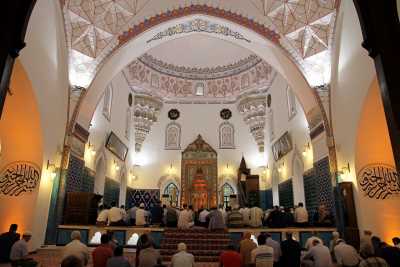Muradiye Cami – Bursa
Kapı kemeri üzerindeki yapım kitabesinden II. Murat tarafından 1425-26 yıllarında yaptırıldığı anlaşılmaktadır. Bursa’da yapılan son sultan camisidir ve daha sonra yapılacak olan anıtsal, çok üniteli sultan camilerinin ilk örneğini oluşturur. Daha önceki camilerden farklı olarak bu caminin iki ana kubbesi eşit yüksekliktedir. Caminin giriş tavanı, ana mekanın duvarlarının alt kısmı; lacivert ve firuze renkli altıgen çinilerle süslüdür. İki minaresinden biri, 1855 depreminde yıkılan minare yeniden yapılmıştır; kuzeybatı köşesindeki eski diğeri yenidir. Mihrap 18. yy başlarında meydana gelen bir yangın sonucu rokoko usulünde yeniden yapılmıştır. Revakın cephesi tuğladan örülmüş geometrik desenlerle ve gök mavisi yıldız biçimindeki çinilerle süslenmiştir. Girişin sağında mavi çiniden iki yıldırım işareti bulunmaktadır. Bunlar II. Murat’ın düşmanlarını yıldırım gibi çarpan bir padişah olduğunun simgeleridir. Kapının sağındaki derviş rozeti de buranın dervişlerin konaklayabilecek bir yer olmasının istendiğini belirtiyor. Caminin içinde bulunan dört dikmenin üzerindeki testere dişini andıran kurşunla doldurulmuş deliklerin caminin inşaatında çalışan işçilerin imzaları olduğu düşünülmektedir. (Kaynak: Bursa İl Kültür ve Turizm Müdürlüğü arşivinden)
English
The Muradiye Mosque
From the construction inscription on the door belt, it is understood that Murat II built the mosque in 1425-26. It is the last sultan mosque constructed in Bursa and is also the first example of a several units sultan mosque. Unlike previous mosques, the two domes of this mosque are equally high. The entrance roof of the mosque is the lower part of the walls of the main room; there are decorated with dark blue and turquoise colored hexagonal china. One of the two minarets was demolished in the earthquake of 1855; The one on the northwest corner is the old one and the other the new one. The mihrab was rebuilt in a rococo style after the fire in the early 18th century. The portico’s head was adorned with brick-lined geometric patterns and cherry-blue stars. To the right of the entrance there is a blue lightning sign. These symbolized the fact that Murat II striked his enemies like a lightning. The dervish rozette on the right side of the door also indicates that the dervishes want there to be a place where to stay. It is believed that the holes filled with lead resembling a sawtooth are a signature of workers working on the construction of the mosque. (Source: Bursa Provincial Directorate of Culture and Tourism)

